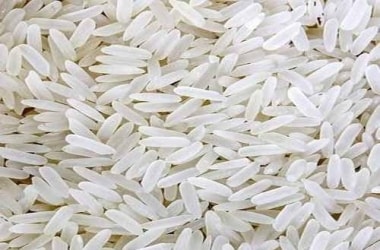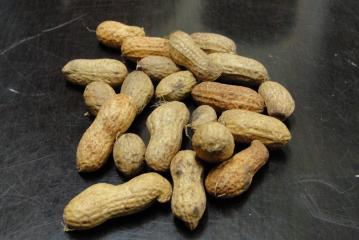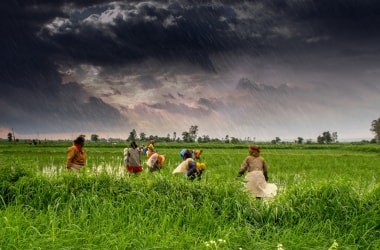Agriculture - Current Affairs for November, 2017
Agriculture Current Affairs for November, 2017
Month wise coverage of Agriculture Current Affairs helps you improve your general knowledge and prepare for all competitive exams like IBPS, Bank PO, SBI PO, RRB, RBI, LIC, Specialist Officer, Clerk, SSC, UPSC, Railway etc. This section is updated daily with the most important events.Preparing Agriculture Current Affairs November, 2017
1. Read the most important Agriculture Current affairs and facts here. 2. Take practice test of our Agriculture MCQ and Objective type questions. 3. Clear any quiz, GK, job interview or competitive exam on current affairs.
- Month & Year
▼ Now, rice with low glycemic index and bacterial resistance developed! [11-22-17]
 The Hyderabad based Centre for Cellular and Molecular Biology (CCMB) in association with Indian Institute of Rice Research (IIRR) has developed Improved Samba Masuri (ISM) variety rice with low Glycemic Index (GI).
Rice with low GI is considered suitable for people with diabetics. Consumption of food with low GI results in slow release of glucose into the bloodstream reducing the ill-effects of diabetes.
Samba Masuri (ISM) rice variety has twin advantages of being resistant to Bacterial Blight (BB) and at the same time also beneficial to the overall health of the body.
According to researchers, at present 40 per cent of the normal Samba Masuri crop is being lost due to Bacterial Blight. However, the new ISM variety of rice will significantly reduce this crop loss, which eventually would lead to reduced prices of rice and increased profit margins for farmers and traders.
The rice has the lowest Glycemic Index (GI) at 50.9 among all major rice varieties, which is an improvement over the 52.9 GI of earlier Samba Masuri variety.
The traditional Samba Masuri rice is commonly called Sona Masuri and Kurnool Masuri and has very low resistance to BB, a pest disease for which there is no chemical solution yet.
The Improved Samba Masuri is not at all Genetically Modified (GM).
According to researchers, farmers have already cultivated ISM in 1,30,000 hectares in 2016 and another 1,00,000 hectares in 2017 Kharif season, across seven States including TS and AP.
The old Samba Masuri rice is estimated to be cultivated over four million hectares across the country, annually. The Hyderabad based Centre for Cellular and Molecular Biology (CCMB) in association with Indian Institute of Rice Research (IIRR) has developed Improved Samba Masuri (ISM) variety rice with low Glycemic Index (GI).
Rice with low GI is considered suitable for people with diabetics. Consumption of food with low GI results in slow release of glucose into the bloodstream reducing the ill-effects of diabetes.
Samba Masuri (ISM) rice variety has twin advantages of being resistant to Bacterial Blight (BB) and at the same time also beneficial to the overall health of the body.
According to researchers, at present 40 per cent of the normal Samba Masuri crop is being lost due to Bacterial Blight. However, the new ISM variety of rice will significantly reduce this crop loss, which eventually would lead to reduced prices of rice and increased profit margins for farmers and traders.
The rice has the lowest Glycemic Index (GI) at 50.9 among all major rice varieties, which is an improvement over the 52.9 GI of earlier Samba Masuri variety.
The traditional Samba Masuri rice is commonly called Sona Masuri and Kurnool Masuri and has very low resistance to BB, a pest disease for which there is no chemical solution yet.
The Improved Samba Masuri is not at all Genetically Modified (GM).
According to researchers, farmers have already cultivated ISM in 1,30,000 hectares in 2016 and another 1,00,000 hectares in 2017 Kharif season, across seven States including TS and AP.
The old Samba Masuri rice is estimated to be cultivated over four million hectares across the country, annually.
|
▼ ICRISAT researchers develop groundnuts free of toxic fungi [11-10-17]
 Researchers at the International Crops Research Institute for the Semi-Arid Tropics (ICRISAT) in Hyderabad have developed dual strategies to keep groundnuts almost free of aflatoxin - a toxin produced by the fungi Aspergillus flavus and Aspergillus parasiticus - contamination.
While one strategy prevents groundnuts from being infected by the fungus thereby preventing the toxins from being produced, the other strategy prevents the fungus from producing the toxin even if groundnuts somehow get infected with the fungus.
Genetic engineering approaches were used for inserting two alfalfa genes into groundnut plants to enhance immunity against fungal infection and growth. Preventing aflatoxin production even in case of any infection was achieved through a plant-induced gene silencing technique.
While both strategies showed promising results, the ultimate goal is to combine the two traits into a single variety to offer double protection so that groundnuts do not accumulate any aflatoxin or the amount of toxin is well within permissible limits at or after harvest.
To further prevent toxin production even when groundnuts get infected with the fungus, the researchers designed two small RNA molecules that silence the fungal genes which produce aflatoxin.
When the fungus and plant come in contact with each other the small RNA molecules from the plant enter the fungus and prevent it from producing aflatoxin.
About 40 hours after infection with Aspergillus, six lines with alfalfa genes showed less than 1 part per billion (ppb) of toxin and another five lines showed 1-4 ppb compared with over 3,000 ppb in groundnuts that did not have these genes.
Similarly, six lines carrying the RNA molecules, the toxin present was less than 1 ppb and two other lines showed 1-4 ppb of toxin.
It is much lower than the Indian and U.S. safety limit of 20 ppb and meets even the stringent European safety limit of 4 ppb. Researchers at the International Crops Research Institute for the Semi-Arid Tropics (ICRISAT) in Hyderabad have developed dual strategies to keep groundnuts almost free of aflatoxin - a toxin produced by the fungi Aspergillus flavus and Aspergillus parasiticus - contamination.
While one strategy prevents groundnuts from being infected by the fungus thereby preventing the toxins from being produced, the other strategy prevents the fungus from producing the toxin even if groundnuts somehow get infected with the fungus.
Genetic engineering approaches were used for inserting two alfalfa genes into groundnut plants to enhance immunity against fungal infection and growth. Preventing aflatoxin production even in case of any infection was achieved through a plant-induced gene silencing technique.
While both strategies showed promising results, the ultimate goal is to combine the two traits into a single variety to offer double protection so that groundnuts do not accumulate any aflatoxin or the amount of toxin is well within permissible limits at or after harvest.
To further prevent toxin production even when groundnuts get infected with the fungus, the researchers designed two small RNA molecules that silence the fungal genes which produce aflatoxin.
When the fungus and plant come in contact with each other the small RNA molecules from the plant enter the fungus and prevent it from producing aflatoxin.
About 40 hours after infection with Aspergillus, six lines with alfalfa genes showed less than 1 part per billion (ppb) of toxin and another five lines showed 1-4 ppb compared with over 3,000 ppb in groundnuts that did not have these genes.
Similarly, six lines carrying the RNA molecules, the toxin present was less than 1 ppb and two other lines showed 1-4 ppb of toxin.
It is much lower than the Indian and U.S. safety limit of 20 ppb and meets even the stringent European safety limit of 4 ppb.
|
▼ CCEA approves RVKY-RAFTAAR scheme [11-2-17]
 The Cabinet Committee on Economic Affairs chaired by the Prime Minister Shri Narendra Modi, has approved the continuation of Rashtriya Krishi Vikas Yojana (RKVY) as Rashtriya Krishi Vikas Yojana- Remunerative Approaches for Agriculture and Allied sector Rejuvenation (RKVY-RAFTAAR) for three years i.e. 2017-18 to 2019-20.
The financial allocation of the scheme will be INR 15,722 crore with the objective of making farming as a remunerative economic activity through strengthening the farmer’s effort, risk mitigation and promoting agribusiness entrepreneurship.
RKVY-RAFTAAR funds would be provided to the States as 60:40 grants between Centre and States (90:10 for North Eastern States and Himalayan States) through the following streams:
(a) Regular RKVY-RAFTAAR (Infrastructure & Assets and Production Growth) with 70%of annual outlay to be allocated to states as grants based for the following activities:
i. Infrastructure and assets with 50% of regular RKVY-RAFTAAR outlay.
ii. Value addition linked production projects with 30% of regular RKVY-RAFTAAR outlay.
iii. Flexi-funds with 20% of regular RKVY-RAFTAAR outlay. States can use this for supporting any projects as per the local needs.
(b) RKVY-RAFTAAR special sub-schemes of National priorities - 20% of annual outlay; and
(c) Innovation and agri-entrepreneur development through creating end-to-end solution, skill development and financial support for setting up the agri-enterprise -10% of annual outlay including 2% of administrative costs.
The scheme will incentivise States in enhancing more allocation to Agriculture and Allied Sectors.
This will also strengthen farmer’s efforts through creation of agriculture infrastructure that help in supply of quality inputs, market facilities etc.
This will further promote agri-entrepreneurship and support business models that maximize returns to farmers.
RKVY: Know More The Cabinet Committee on Economic Affairs chaired by the Prime Minister Shri Narendra Modi, has approved the continuation of Rashtriya Krishi Vikas Yojana (RKVY) as Rashtriya Krishi Vikas Yojana- Remunerative Approaches for Agriculture and Allied sector Rejuvenation (RKVY-RAFTAAR) for three years i.e. 2017-18 to 2019-20.
The financial allocation of the scheme will be INR 15,722 crore with the objective of making farming as a remunerative economic activity through strengthening the farmer’s effort, risk mitigation and promoting agribusiness entrepreneurship.
RKVY-RAFTAAR funds would be provided to the States as 60:40 grants between Centre and States (90:10 for North Eastern States and Himalayan States) through the following streams:
(a) Regular RKVY-RAFTAAR (Infrastructure & Assets and Production Growth) with 70%of annual outlay to be allocated to states as grants based for the following activities:
i. Infrastructure and assets with 50% of regular RKVY-RAFTAAR outlay.
ii. Value addition linked production projects with 30% of regular RKVY-RAFTAAR outlay.
iii. Flexi-funds with 20% of regular RKVY-RAFTAAR outlay. States can use this for supporting any projects as per the local needs.
(b) RKVY-RAFTAAR special sub-schemes of National priorities - 20% of annual outlay; and
(c) Innovation and agri-entrepreneur development through creating end-to-end solution, skill development and financial support for setting up the agri-enterprise -10% of annual outlay including 2% of administrative costs.
The scheme will incentivise States in enhancing more allocation to Agriculture and Allied Sectors.
This will also strengthen farmer’s efforts through creation of agriculture infrastructure that help in supply of quality inputs, market facilities etc.
This will further promote agri-entrepreneurship and support business models that maximize returns to farmers.
RKVY: Know More
- Rashtriya Krishi Vikas Yojana (RKVY) is a continuing scheme under implementation from XI Five Year Plan.
- The scheme provides considerable flexibility and autonomy to states in planning and executing programmes for incentivising investment in agriculture and allied sectors.
- States initiate the process of decentralized planning for agriculture and allied sectors through preparation of District Agriculture Plans (DAPs) and State Agriculture Plan (SAP) based on agro-climatic conditions, availability of appropriate technology and natural resources to ensure accommodation of local needs, cropping pattern, priorities etc.
- RKVY has also enabled adoption of national priorities without affecting the autonomy and flexibility of States through sub-schemes.
- National priorities like Bringing Green Revolution to Eastern India (BGREI), Crop Diversification Program (CDP), Reclamation of Problem Soil (RPS), Foot & Mouth Disease - Control Program (FMD-CP), Saffron Mission, Accelerated Fodder Development Programme, etc. are being implemented through the window of RKVY.
- During XI Plan and XII Plan, States have taken over 13,000 projects in agriculture and allied sector through State Agriculture Department as Nodal Implementing Agency.
- The interim report of RKVY evaluation done by Institute of Economic Growth summarizes that the income emanating from agriculture measured as the agricultural state domestic product (AGSDP) is higher in the post-RKVY period than in the pre-RKVY period.
- Further, almost all the states registered higher value of output from agriculture and allied activities in the post-RKVY period.
- Continuation of RKVY-RAFTAAR will therefore keep the momentum of agriculture and allied sector growth.
|